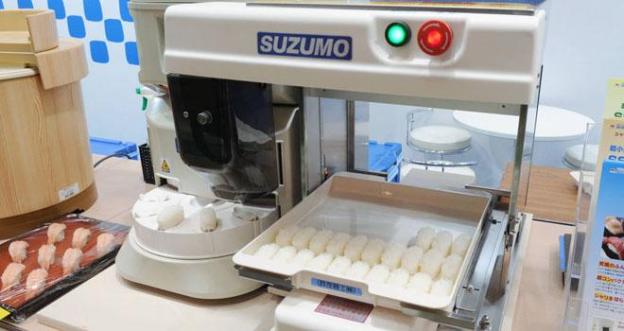
The Asian culinary craft is one of utmost expertise. You have the intricate artistry of slicing Peking duck into perfect, thin pieces, and the detailed ways of rolling dumplings into their tiny little shapes. But the most celebrated art of Asian cuisine commonly found in the United States is making sushi, which is about to become obsolete now that this Suzumo sushi robot is in the picture.
The SushiBot was unveiled at World Food and Beverage Great Expo in Tokyo, Japan last week. This countertop-sized contraption reportedly has the power to manufacture 1,000 rolls per hour, which can then be sliced into 3,600 pieces. This means that for every second of a minute, SushiBot is furiously grabbing sticky vinegared rice and shaping it into a sushi roll. However, sushi chefs shouldn’t give up and find a new career just yet. Though SushiBot is certainly fast, a human supplier is still needed to feed the robot ingredients manually. One version of the SushiBot also only pumps out oval mounds, meaning chefs also have to place the pieces of fish or other seafood on top of the rice themselves.
Suzumo has been producing food robots since the company’s establishment in 1961. According to a promotional video of older SushiBot models in 2009, the machines are designed to “precisely recreate the handmade taste and technique used by an experienced sushi chef.” All that’s missing is another robot to actually cut and mix ingredients.
While no one has come out to say if SushiBot actually makes quality sushi that can rival manmade creations, an idea of a sushi-making robot could be helpful in preventing the spread of germs of handcrafted sushi. Additionally, we can see SushiBot serving a giant party where you could replace a caterer with the bot to ensure food supplies never go low. Its kitchen-appropriate sizing might also mean we can see this useful in supermarkets or sports stadium concessions… you know, places where food quality isn’t that important as long as you can get some munchies for the duration.
However, with robots quickly trying to replace human jobs, we’d be scared to think of walking into an authentic Japanese restaurant only to find a bunch of metal parts putting together our meals. Hopefully, things like the SushiBot are only here to help human save time, not take away our jobs altogether. Besides, what if someone has a certain food allergy or refuses to have wasabi in their sushi rolls? SushiBot wouldn’t be able to respond to that.
If you want to see just how fast SushiBot can roll out sushi, here are two videos of the SushiBots pumping out their creations. Mmh, metal!


